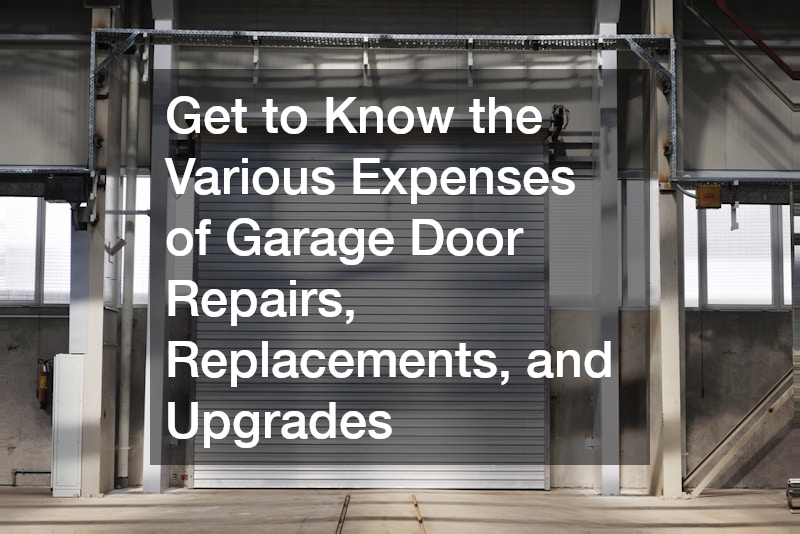
Building and maintaining a secure and functional garage is often one of the most important aspects of homeownership. The garage can provide a safe place to store vehicles, tools, and other valuable belongings, while also serving as a key entry point into your home. Yet many homeowners find themselves caught off-guard by the complexities and costs involved in maintaining, upgrading, or replacing different garage components. From small fixes like repairing a broken sensor to large-scale overhauls such as installing an entirely new door, each project carries its own price tag and requirements. The good news is that by understanding the factors that influence the cost of these services, you can plan ahead and make more informed decisions.
In this blog, we’ll delve into the common expenses linked to garage door repair, replacements, and various upgrades. You’ll learn why the costs can vary widely, what you can do to keep those costs in check, and how certain types of projects may offer a better long-term value than others. If you’ve ever wondered whether you should replace a door altogether or simply fix its malfunctioning parts, this guide will help clarify the pros, cons, and investment returns of each option. Additionally, we’ll explore how certain features—like screens or advanced security measures—can improve not only the door’s functionality but also your overall garage experience.
Understanding the Basics of Garage Door Expenses
One of the first questions homeowners often ask is why the cost of garage door services can fluctuate so significantly. The answer usually lies in the variety of materials, brands, and designs available. From traditional wood and steel doors to modern aluminum and composite variants, each type comes with its own unique price range. A simple steel door might be more affordable, but a wooden door could offer a richer aesthetic—albeit at a higher cost.
Labor is another major factor. A reputable garage door company may charge different rates depending on location, complexity of the job, and the technicians’ level of expertise. Highly skilled professionals tend to charge more, but they can often diagnose and resolve issues more efficiently, potentially saving you money and headaches over the long haul. Additionally, older garage door systems might involve parts that are either difficult to find or more expensive to replace, driving up repair costs.
It’s also worth noting that routine problems like a stuck door or loud operation can sometimes signal deeper issues. For example, if you have a broken spring, you might think a minor fix will suffice. But ignoring worn-out garage door torsion springs could lead to a door malfunction that damages other components of your system. When comparing estimates, always verify whether you’re paying merely for a cosmetic patch or a thorough solution that addresses the root cause. Understanding the difference can mean the distinction between a small bill now and a massive bill in the future.
Beyond the door itself, homeowners often overlook how the garage integrates into the broader security of their home. An access and security control system can add an extra layer of safety, but it also factors into the total expense. While such features might not be strictly necessary, they can offer peace of mind, especially if the garage serves as a main entrance or stores high-value items. As you evaluate costs, consider how much value you place on security. Paying more upfront for advanced technology can be a smart decision in the long term, particularly if it deters potential break-ins or vandalism.
The True Cost of Repairs
When the average homeowner notices their garage door making strange noises or not opening as smoothly, the immediate inclination might be to seek a basic garage door repair. Costs for such repairs can range from surprisingly low to quite steep, depending on the type of problem. A minor track alignment or lubrication is usually inexpensive, but problems involving the springs, cables, or opener mechanisms often carry higher price tags. Plus, if you call in a professional on an emergency basis outside of regular working hours, expect to pay a premium.
A critical component that often contributes to repair costs is the set of springs holding up the garage door. Over time, springs become stressed from the weight they support and the repeated motion of opening and closing. If you own a door with garage door torsion springs, you may eventually face the need for garage door spring replacements. While this is a relatively common issue, it’s not one to take lightly. A broken spring can render your door inoperable and even pose a safety risk. Having a trusted technician handle the replacement ensures the job is done safely and correctly, though you can expect to pay for both labor and the cost of quality springs themselves.
Sometimes, the repair doesn’t involve broken springs or bent tracks but rather the door opener. If you have an older system, you might experience persistent malfunctions like unreliable remote signals or jerky door movement. Upgrading to a newer model, such as the widely recognized liftmaster garage door openers, can be more cost-effective in the long run than continuing to patch up outdated technology. Though the initial expense may seem higher than a simple fix, a modern opener often comes with improved safety features and quieter operation, enhancing both convenience and home security.
No matter the issue, it’s wise to get a detailed estimate before approving any work. The estimate should outline parts, labor, and any necessary fees, ensuring no hidden charges creep up later. Since pricing can vary by region and by provider, consider calling more than one garage door company for a quote. Comparing professionals can help you find not only the best price but also the most reliable and reputable service. In the end, a well-informed decision on repairs can stave off more serious complications and costs down the line.
Weighing Repair Costs Against Replacement
Eventually, every garage door reaches the point where continuous repairs are no longer the best financial decision. Frequent malfunctions could indicate deeper structural issues that cost more to fix piece by piece than they would if you replaced the entire door. Some homeowners even opt for garage door replacements preemptively, finding it a better long-term investment—especially if the existing door is outdated or mismatched with the home’s facade.
A brand-new door can also offer improved insulation, which is beneficial for energy savings. If your garage is attached to your home, enhanced insulation can help regulate indoor temperatures, reducing the strain on heating and cooling systems. The result is often a more comfortable living space and potentially lower utility bills. Moreover, a newer door usually comes with advanced features that weren’t available years ago, including better sealing to keep out pests and debris, or even built-in windows for natural light.
There’s also an aesthetic angle to consider. If the door is visible from the street, its appearance can impact your home’s curb appeal. Choosing a modern design or custom finish can elevate your property’s look, which might be important if you’re planning to sell in the near future. While a replacement may demand a higher upfront cost compared to some repairs, it has the potential to yield a strong return on investment. Buyers often view an updated garage door as a sign that the rest of the property is well-maintained.
Naturally, full replacements require an investment in both materials and labor, so it’s prudent to weigh this option against simpler fixes. Getting multiple estimates can help you understand whether your door genuinely needs replacing or if it’s salvageable. Talk to specialists who provide a spectrum of garage door services and inquire about the expected lifespan of your current setup. In many cases, the decision to replace hinges on how the door aligns with the rest of your property goals—be those financial, aesthetic, or functional.
Modern Upgrades and Technology
If you’ve already tackled the basics of repairing or replacing your door, you might be eyeing enhancements that elevate your garage’s convenience and functionality. Upgraded systems go beyond the traditional up-and-down mechanism. From keypad entry units to internet-connected door controls, technology has made garages smarter, safer, and more user-friendly than ever before. Deciding which upgrades are worth the added expense typically comes down to your budget, lifestyle needs, and personal preferences.
Many homeowners look into liftmaster garage door openers when upgrading, thanks to their reliable performance and advanced features. These openers offer powerful lifting capabilities, quiet operation, and may even integrate seamlessly with home automation platforms. Depending on the model, you might monitor and control your garage door remotely through a smartphone app. While the cost for such a feature is higher than a standard opener, the convenience and added security often justify the extra expense.
Beyond openers, there’s a growing interest in garage door screens. These are versatile mesh additions that allow fresh air and natural light to enter while keeping bugs and debris out. They can effectively turn your garage into a more livable space, suitable for hobbies, workouts, or social gatherings. The cost of screens can vary based on material quality and the size of your garage opening, but they can be a relatively affordable way to expand the functional use of the garage.
Another upgrade that’s gaining traction is an access and security control system, often tied to smart home networks. It can include features like camera surveillance, motion sensors, and remote locking. While the cost might be higher initially, the added peace of mind is priceless for many. The expense can also be partially offset if you later decide to sell your home; modern security systems can be a major selling point that appeals to tech-savvy buyers. As you explore these new technologies, consider how each one aligns with your everyday life and your long-term home improvement strategy.
Considering Seasonal and Environmental Factors
Many people forget that environmental conditions can heavily influence the durability and performance of a garage door. Regions with harsh winters, salty sea air, or high humidity can cause metal parts to corrode more quickly or wooden sections to rot. This often translates into more frequent garage door repair tasks. Factoring in your local climate can help you choose the right materials and plan for ongoing upkeep costs. In some cases, you might even weigh whether investing in features like weather stripping or insulated panels is worth the extra expense to combat extreme temperatures.
For homeowners who face limited space or frequent relocation needs, portable garages can sometimes serve as a temporary or auxiliary structure. Though not exactly the same as a permanently installed garage door, portable solutions might require occasional maintenance or upgrades to keep them secure and operational. Costs for these items are usually lower compared to building a traditional garage or installing a new door, but they can add up over time if you’re not careful. Be sure to consider how much maintenance you’re willing to undertake and how often you might move the structure.
Environmental concerns can also affect the type of opener you choose. Some systems might be more resistant to cold weather, while others are optimized to handle salty coastal air. Understanding these nuances can prevent you from investing in technology that underperforms in your climate. Before spending money on any specialized parts or advanced door systems, ask a knowledgeable technician how certain models fare under local environmental conditions. Making an informed choice can stretch your dollar further and reduce the likelihood of unexpected repairs triggered by severe weather or rust.
Balancing Aesthetics with Functionality
When deciding whether to pour funds into new systems, advanced security, or simpler repairs, you’ll eventually have to weigh aesthetics against functionality. A door that enhances your home’s curb appeal can significantly increase property value, but at what cost? The same question applies to advanced gadgets; they’re impressive, but do they offer tangible daily benefits?
Design-related expenses can come from the materials chosen, decorative hardware, or windows integrated into the door panel. A high-end wood door might look luxurious, but it also carries higher maintenance costs, including more frequent refinishing to protect it from the elements. Steel or fiberglass doors might offer a sleek modern look with lower upkeep, but they might lack the warm, traditional vibe of wooden designs. Each aesthetic choice can bring a unique blend of durability, performance, and cost considerations.
If you plan to use the garage for more than just parking—like a workshop, home gym, or spare living space—functionality might trump style. In such cases, features like garage door screens can be more relevant than ornate paneling. Conversely, if your garage faces the street and forms a big part of your home’s facade, you might lean more heavily toward an aesthetically pleasing design that complements the rest of your architecture.
Every decision you make on appearance and functionality affects the overall expense, both immediately and over time. It’s essential to balance your desire for a visually appealing door with practicality and future maintenance requirements. Homeowners who achieve this balance often find that their investment pays off in terms of resale value and daily satisfaction. A well-chosen garage door system can be that sweet spot where style, convenience, and efficiency harmoniously intersect.
Planning for Long-Term Maintenance
No matter how much you spend on your garage door—whether it’s an entry-level model or a top-of-the-line system—neglecting upkeep can lead to costly problems. Regular inspections by a reputable garage door company can catch minor wear and tear before it escalates into major damage. Investing in routine checks might feel like an unnecessary expense, but it often prevents more significant, more expensive issues down the road.
One crucial aspect of maintenance involves the springs. If you replace worn-out garage door torsion springs or maintain them properly, you can avoid a situation where the door suddenly refuses to budge—or worse, collapses unexpectedly. Scheduled lubrication of tracks, hinges, and rollers also extends the door’s life, reducing the likelihood of emergency service calls that can spike your annual home maintenance budget. Even small tasks like tightening loose bolts and cleaning the photo-eye sensors can make a difference in the door’s long-term operation.
Budgeting for recurring maintenance tasks helps keep your finances predictable. Many garage door services offer annual or semiannual checkups at a flat rate, allowing you to plan accordingly. If you’ve invested in advanced features like an access and security control system, you’ll need to factor in any software updates or occasional part replacements for the electronic components as well. These additional costs can be minor compared to the initial outlay, but they’re still worth factoring into your overall home improvement plan.
A proactive mindset ensures that your garage door remains functional and safe for years. By setting aside funds and scheduling periodic tune-ups, you reduce the stress of unexpected breakdowns and costly emergency repairs. This strategy is particularly helpful if your door is on the older side, as the risk of mechanical failure tends to rise with age. Taking care of maintenance as a regular part of homeownership can significantly extend your garage door’s lifespan, making any initial investments more worthwhile.
Comparing DIY and Professional Options
For homeowners looking to save money, the temptation to tackle certain garage door tasks independently is strong. While painting the door or tightening a few bolts might be easily manageable, more complex issues—like garage door spring replacements—can be risky if not handled correctly. Springs operate under high tension; one wrong move can lead to serious injuries. Even opener installations have specific requirements to ensure they function safely and comply with local building codes.
If you’re handy with tools and have relevant experience, certain minor repairs can indeed be done DIY-style. However, you’ll still need to invest in the right equipment and parts. For larger tasks, relying on a trained technician might prove more cost-effective in the long term, as it prevents additional damage that could arise from trial-and-error attempts. A professional garage door company can also offer warranties on parts and labor, giving you a safety net if something goes awry after the repair or installation is finished.
In some cases, combining a bit of DIY with professional help is a winning strategy. For instance, you might install a set of garage door screens on your own, but leave the calibration of your liftmaster garage door openers to an expert. This hybrid approach allows you to cut down on labor costs without compromising safety on complex tasks. It’s all about knowing your limits and calculating whether the potential savings are worth the added risk.
Ultimately, the DIY-versus-professional decision comes down to comfort level, skill set, and how crucial a reliable garage door is to your household. If the garage is your main entry point or safeguards expensive belongings, you might lean more heavily on specialists. On the other hand, if you view minor tasks as a manageable hobby, a do-it-yourself approach can reduce your total expenses. The key is to weigh short-term cost savings against the long-term reliability of a job well done.
Making the Final Decision
As you can see, the expenses linked to garage door repairs, replacements, and upgrades can vary widely, influenced by factors like materials, labor, technological features, and even local climate. The good news is that you have options. You can choose to invest in routine maintenance and smaller repairs to extend your door’s life, or you may decide that installing new hardware—such as liftmaster garage door openers—offers superior convenience and reliability. If you’re feeling adventurous or have unique spatial needs, exploring portable garages might be a flexible solution, although it may require periodic attention to remain secure.
Homeowners who crave a bit of fresh air without the nuisances of bugs might install garage door screens, turning the garage into a versatile area that can accommodate everything from workouts to family gatherings. On the higher end of the scale, an access and security control system can give you unparalleled oversight, locking capabilities, and integration with other smart home devices. Though these amenities can raise initial costs, they often pay dividends in safety and convenience.
Deciding where and how to allocate your resources is a highly personal choice. Aesthetic preferences, budget constraints, functional needs, and long-term homeownership plans all factor into your final decision. The important thing is to approach these costs with eyes wide open, armed with the knowledge of what’s necessary, what’s optional, and how each project affects your home’s value.
When in doubt, consult a trusted professional. Whether it’s an experienced garage door company for major tasks or a smaller garage door services provider for routine checkups, expert insight can guide you toward solutions that suit your situation. It’s not just about finding the cheapest path; it’s about ensuring your garage door is safe, reliable, and aligned with how you want to use this vital part of your home.





